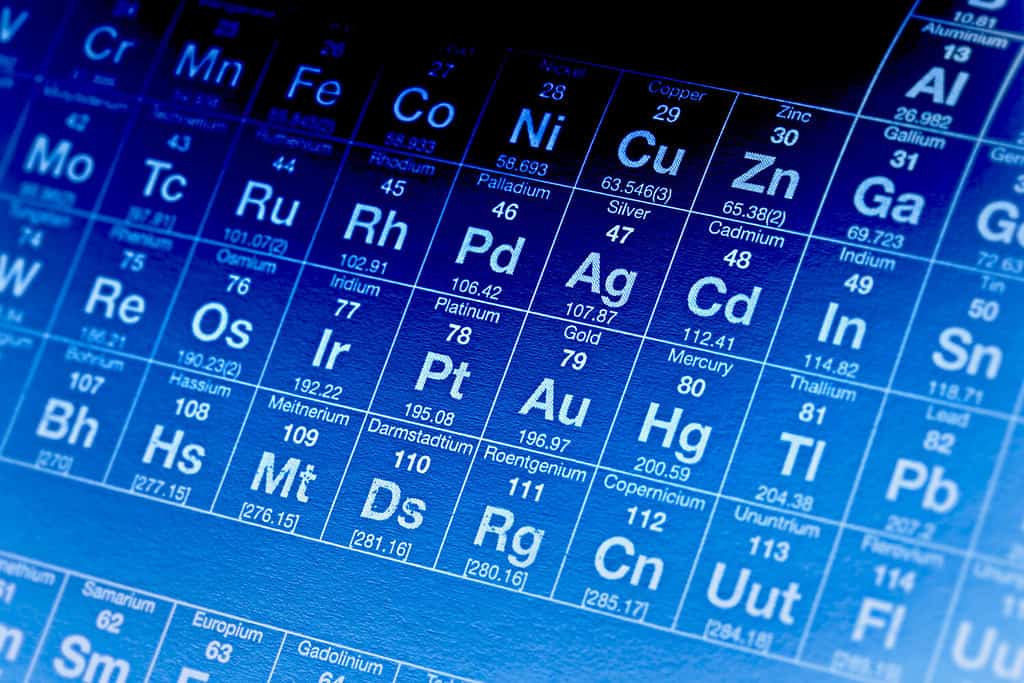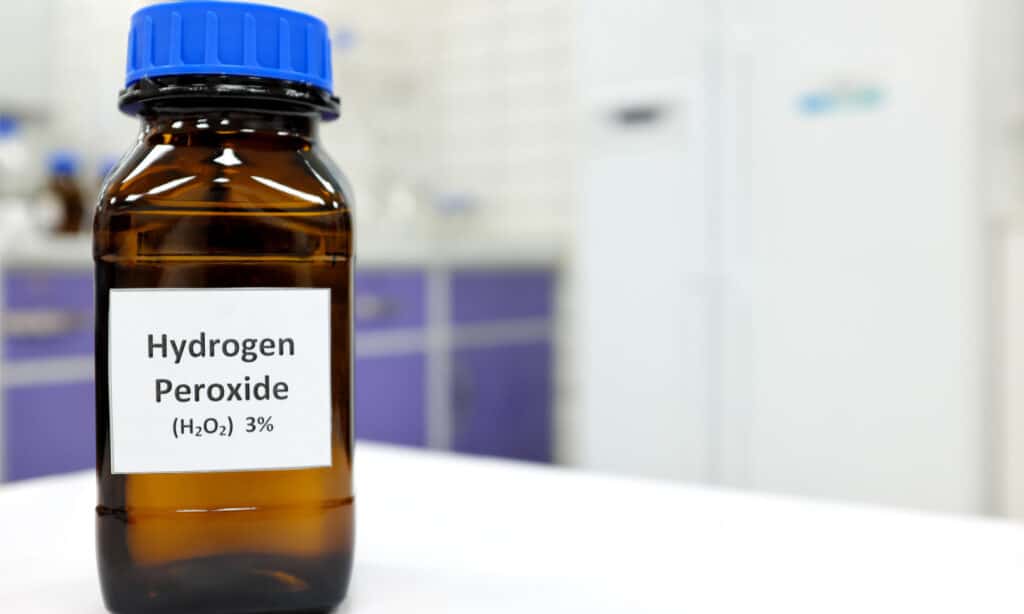Introduction
Did you know that hydrogen is the most abundant element in the universe? Represented by the letter H, hydrogen is found in many molecules and compounds that have practical uses in our world today. For instance, hydrogen forms water, which is the source of life. However, the element also creates chemicals like ammonia, which is often incorporated into cleaning products. Overall, hydrogen is an extremely important element for creating and sustaining life on Earth. Discover the molar mass of hydrogen and see how it compares with other elements on the periodic table.

Hydrogen atoms combine with oxygen to form water molecules, creating one of the most important sources of life.
©iStock.com/seb_ra
What is Hydrogen?
While hydrogen is the simplest element listed on the periodic table, it is one of the most important elements in sustaining life. Furthermore, the element has no color or taste and takes the form of a gas. While the description of hydrogen may seem unimpressive overall, its qualities and uses continue to develop and have great potential in medicine, scientific research, and chemistry.
Hydrogen atoms are comprised of a central nucleus surrounded by an electron with a negative charge. In addition, the nucleus contains one proton with a positive charge. While many other elements in the periodic table bear more than one electron in their atoms, hydrogen only contains one encircling electron.
Hydrogen gas is made up of several hydrogen molecules, which are comprised of two hydrogen atoms with the chemical formula H2. Hydrogen is particularly important because it combines with oxygen to form water, signified by the formula H2O. In addition, hydrogen is the most plentiful element in the entire universe. No other element naturally occurs as frequently as hydrogen. On Earth, the element is found in water sources like oceans and rivers and ice, glaciers, and air.
What is Molar Mass and How is it Calculated?
To understand the molar mass of an element, we must look at the concept of moles. The term “mole” describes the number of small entities, such as atoms or molecules, within the mass of an element or compound. To calculate moles, scientists and chemists use a value called Avogadro’s number. Amadeo Avogadro first theorized Avogadro’s number, which describes the number of atoms or molecules within one mole. The number is 6.022 x 1023.
Scientists calculate molar mass by dividing a substance’s mass (in grams) by the number of moles of a substance. The periodic table lists the molar mass of single elements below their nomenclature. These values sit underneath the nomenclature of a specific element. However, these values are often referred to as the atomic mass of an element, rather than the molar mass. To report the molar mass of a single element, reference the atomic mass value and add the unit g/mol.

Mole Day is celebrated on October 23rd between 6:02 a.m. and 6:02 p.m., and the time and date values derive from Avogadro’s number.
©Ekaterina_Minaeva/Shutterstock.com
Molar Mass of a Molecule
For a compound or molecule, though, finding molar mass requires further steps. Take H2O, or water, for example. The atomic mass of hydrogen (H) is 1.00784, and the atomic mass of oxygen (O) is 15.9994. In a water molecule, two hydrogen atoms are present alongside one oxygen atom. Thus, the molar mass equation must account for a compound’s number of atoms of a certain element.
Therefore, calculating the molar mass of the hydrogen atoms in H2O is demonstrated through the equation 2 x 1.00784. Calculating the molar mass of the oxygen atom in H2O is demonstrated through the equation 1 x 15.9994. From there, the sum of the products of both equations gives us the molar mass of H2O. Thus, the molar mass equation is outlined below:
(2 x 1.00784) + (1 x 15.9994) = 18.01508 g/mol
Thus, the molar mass of water rounds to the value of 18.
What is the Molar Mass of Hydrogen?
Hydrogen (H), being a single element, has a molar mass that is easy to find. The periodic table lists hydrogen’s molar mass below the letter H. However, the element hydrogen typically appears as hydrogen gas or in water. The molar mass of water is listed above, but what is the molar mass of hydrogen gas? The chemical formula for hydrogen gas is H2, meaning hydrogen gas is comprised of two hydrogen atoms. Thus, the equation for finding the molar mass of hydrogen gas is as follows:
2 x 1.00784 = 2.016 g/mol
Molar Mass of Hydrogen vs. Other Elements: A Comparison
| Element | Chemical Formula | Molar Mass |
|---|---|---|
| Hydrogen | H | 1.00784 g/mol |
| Sodium | Na | 22.98977 g/mol |
| Carbon | C | 12.011 g/mol |
| Nitrogen | N | 14.007 g/mol |
| Oxygen | O | 15.9994 g/mol |
| Chlorine | Cl | 35.45 g/mol |
| Zinc | Zn | 65.4 g/mol |
| Iodine | I | 126.9045 g/mol |

The periodic table lists the molar masses of single elements.
©isak55/Shutterstock.com
Molar Mass of Hydrogen Molecules and Compounds: A Comparison
| Molecule/Compound | Chemical Formula | Molar Mass |
|---|---|---|
| Hydrogen Gas | H2 | 2.016 g/mol |
| Water | H2O | 18.01508 g/mol |
| Chloroform | CHCl3 | 119.38 g/mol |
| Ammonia | NH3 | 17.031 g/mol |
| Hydrofluoric Acid | HF | 20.0063 g/mol |
| Ethanol | C2H6O | 46.08 g/mol |
Why is Hydrogen Important?
There are numerous reasons why hydrogen is crucial to sustaining life. For one, the element helps power the sun. A chemical reaction within the sun alters the properties of hydrogen to turn it into helium. In addition, hydrogen atoms are necessary for forming water molecules. Water is typically thought of as the source of all life in science, literature, art, and more. Therefore, the sun’s heat and light transported to Earth alongside the presence of water are what allows life to thrive here. Without these natural elements, life would not exist. Thus, we have hydrogen to partially thank for living in this beautiful world.
There are also common uses for hydrogen, and many people encounter hydrogen every day without realizing it. For example, hydrogen can be found in various chemical products and fertilizers. Ammonia is a common compound containing hydrogen, and it is in products such as window cleaners, toilet cleaners, or furniture polish. In addition, the creation of methyl alcohol requires hydrogen, and methyl alcohol is found in paint strippers, paint, ink, and more.
Furthermore, some activities require hydrogen, such as welding. Welders use oxyhydrogen torches to melt various metals. To power the torches, a chemical reaction between the elements oxygen and hydrogen occurs. Thus, extreme heat that helps melt metals down results from the reaction.
Another activity that uses hydrogen is dental care. Some people choose to swish hydrogen peroxide in their mouths, as opposed to mouthwash. Hydrogen peroxide can reduce bacteria, clean out infections, and whiten teeth. In fact, many whitening products found in stores contain hydrogen peroxide.

Hydrogen peroxide includes many everyday uses, such as cleaning wounds or whitening teeth.
©John Kevin/Shutterstock.com
Hydrogen as a Clean Energy Source
As climate change continues to harm animals, habitats, environments, and health around the globe, researchers are continuously searching for clean energy sources that can mitigate the damage done by fossil fuel emissions. One alternative to greenhouse gas emissions is hydrogen. Hydrogen fuel cells are a kind of energy provider that can power cars, buses, homes, businesses, and more. While hydrogen fuel cells are expensive, they could be the future of clean energy.
But how do hydrogen fuel cells work? Take a hydrogen fuel cell-powered bus, for example. The hydrogen fuel cell uses energy created by a chemical reaction between hydrogen and oxygen to power the bus. Rather than releasing carbon dioxide (CO2) into the atmosphere, though, the bus releases water. The product emitted by the chemical reaction takes the form of water.
Furthermore, several benefits accompany hydrogen fuel cell energy. For one, water as an emission leaves no harmful impact on the environment or the atmosphere. In addition, hydrogen fuel cell use reduces the need for fossil fuels, an action that would slow climate change. Moreover, carbon dioxide, which is the primary greenhouse gas that contributes to climate change, does not result from the use of hydrogen fuel cell energy.
However, one downside to hydrogen fuel cell use is that energy is still needed to produce the hydrogen gas used in the clean energy resource. Thus, burning fossil fuels to produce hydrogen fuel cells and hydrogen gas would contribute to climate change, and the resulting hydrogen fuel cells might not make up for nonrenewable energy lost in their production.

One downside of hydrogen fuel cell manufacturing is that it releases fossil fuels into the atmosphere, which contribute to climate change.
©iStock.com/Максим Шмаков
The photo featured at the top of this post is © Intothelight Photography/Shutterstock.com
Thank you for reading! Have some feedback for us? Contact the AZ Animals editorial team.






